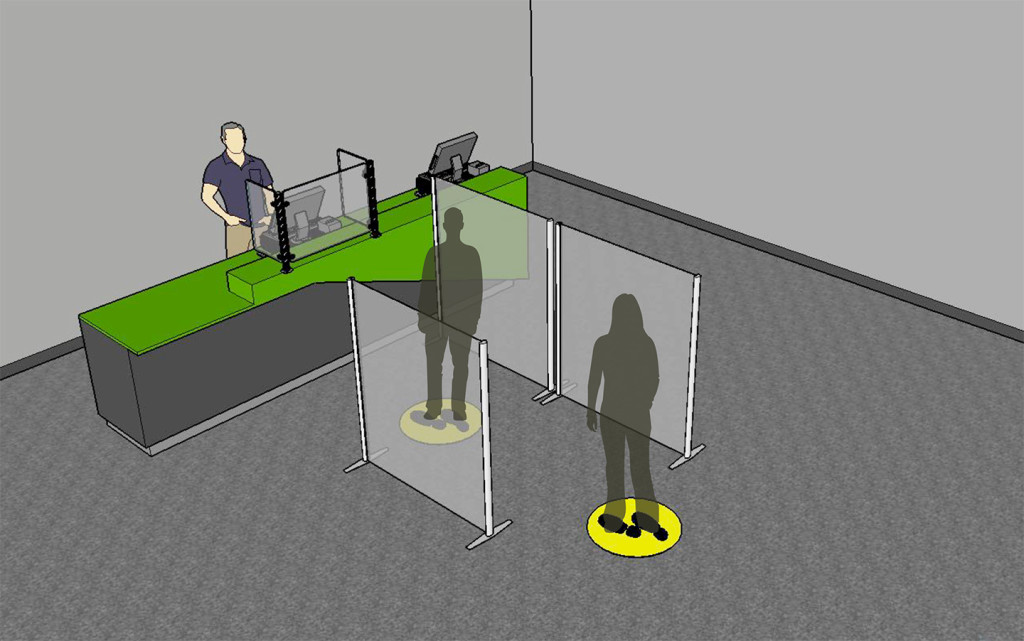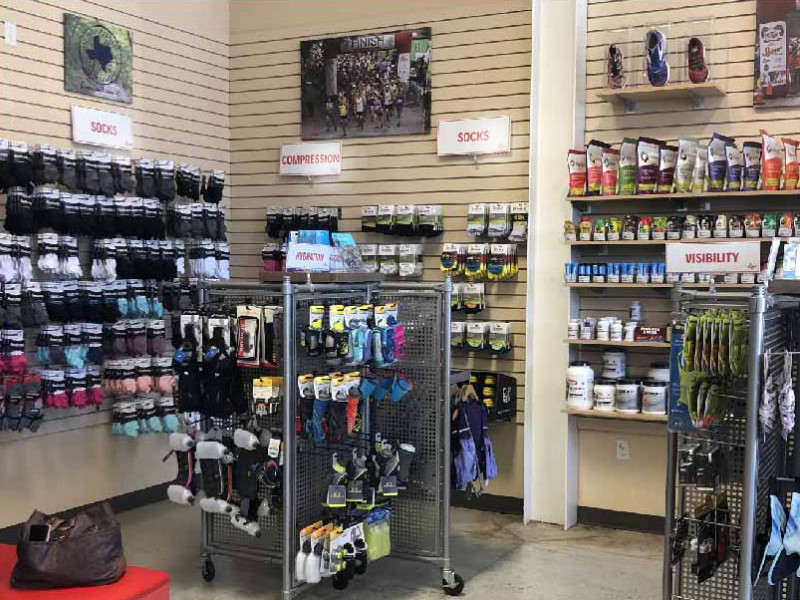What adjustments do run specialty retailers have to make to their stores before reopening? This is the million-dollar question that every retailer has been asking these past few weeks as the country – and their stores – gradually reopen.
What types of safety precautions and procedural changes are going to be necessary to not only ensure the safety of your staff and customers, but almost equally as important, ensure that your customers feel safe enough to leave their homes and decide to enter your store again?
It has become abundantly clear that the task of creating a mental and emotional level of comfort with customers is going to present even more challenges than adhering to the actual safety guidelines that will be required. Why? Because that piece is intangible.
It’s difficult to know exactly how much is enough to quell the anxiety of a nervous customer, but in our opinion no reasonable amount of effort to ensure their comfort is too much. If you can implement any process or protocol that helps you regain your customer’s trust, then it’s worth your time and effort.
Everyone is familiar with the important safety signs, sanitizer displays, floor stickers and sneeze guards that have been circling around on email strings as “retail must-haves” before you reopen, but what about the merchandising of your space? Are there additional things you can do within your store walls that will help ensure further safety for your customers and help to regain their trust?
What follows are ideas that may help ensure some further social distancing in your store and additional layers of safe shopping for your customers.
Store Layout Comes First
Take a close look at the positioning of your floor fixtures. Are they set up in a way that allows your customers to safely walk throughout your entire space without having to touch any product or fixtures at all? And do they ever lead your customers to a potential dead end, or an area where they may feel uncomfortably close to another shopper should they decide to follow a similar path?
The main thing is that you’re stepping back and looking at all areas of your space. If you have any potential pinch points in your traffic flow, then rearrange or, better yet, remove a fixture or two from the floor right now to open things up.
In other words, all fixtures should allow for your customer to navigate them with ease and have a “way out” in the opposite direction, should another customer approach.
Other areas to consider:
• Shoe fitting. If you are still performing actual shoe fitting, are the benches or chairs situated in a way so that even if somebody is sitting on each one of them at the same time, there is adequate space between everybody else? Should you consider placing freestanding plexiglass dividers between any of the benches to further ensure social distancing?
• Cash wrap. Do you have a very clear process for customers to approach the counter, handle the transaction quickly and with minimal contact and then have them exit without getting in the way of other customers who may be needing to pay? Most stores will have restrictions on how many customers can be in the store at the same time, but even with less shoppers you don’t want them bumping into each other, or even getting close to doing so, when they are checking out.
Floor stickers with directional arrows are a good place to start, as well as freestanding acrylic dividers to separate checkout lanes if you’ve got multiple stations running at the same time. If you have only one register operating right now, perhaps lining the approach to it with some dividers would be helpful, allowing for a clear exit for your customer near the counter so that they don’t have to backtrack into the next customer in line behind them.
Apparel Merchandising Challenge
From a product merchandising perspective, the categories of apparel and nutrition stand out to us as potentially higher risk for your customers to shop than others due to their “high touch” nature.
Apparel, of course, poses the most significant challenge as retailers balance space constraints with a need to properly merchandise a key category.
The reality is that in a traditional apparel buying experience multiple people are pulling fitted clothing over their heads (which means nose and mouth), potentially contaminating fabrics without knowing it along the way. While a porous fabric is unlikely to hold on to these viruses for longer than 24-36 hours, within that period of time it’s still possible for several customers to touch or try on the same apparel item.
So how do we fix this?
• Not allowing trying-on of apparel (sounds crazy but this whole situation is crazy). Create a simple sign stating that to help mitigate the risk of transferring the COVID-19 virus through your apparel, you have temporarily suspended any trying-on in the store. If a customer wants to purchase it, allow them to try it on at home and return later. You will know then that it has been touched and can be quarantined for several days in a “dirty” zone in your store where touched items take a “time out” until possible virus droplets have left town.
• Featuring four or five key outfits on mannequins at a time and pulling all other apparel off the floor to be kept in the backroom is another option. Create a sign that says something like, “We have lots of sizes in the back, but to mitigate the spread of the COVID 19 virus through our apparel, our gloved and masked staff members will happily retrieve the size and style you are interested in purchasing. We’re sorry, we are not allowing in-store trying-on at this time.” Your staff can safely go pull what is requested and, just as in the first scenario, if a return happens later with this product you can quarantine it properly before returning it to inventory.
• Less apparel on the floor in general is a good idea in a COVID-19 world. Pull some amount off the floor in order to create less points of human contact in this category. Try to make it so more apparel can be seen easily without having to thumb through packed fixtures. Rotate some new pieces in weekly, but contain it to as few floor fixtures as possible. Less product, less fixtures, less points of contact are all good things right now.
Handling Nutrition
And then there is the profitable nutrition segment.
It goes without saying that sampling is out, but beyond that how about customers thumbing through the gels, bars or other small items that are often displayed in boxes or bins? Is it a concern to be increasing the number of points of contact between customers and these products? And if so, are there any other options to sell this category?
What about pulling backstock of nutrition out of the front area, similar to what is suggested for apparel, and have signs indicating that product can be easily pulled by safe staff members for those interested in larger nutrition purchases.
The thought is that much like a high-end bakery, where display-only products are in the cases, perhaps consider displaying singles of your top nutrition products only. When people want several bars or gels, they can ask a staff member to go grab them and put them in a bag in the back to eliminate sorting through all the bins on the floor fixture.
More work? Absolutely. Less points of human contact on a product to be consumed? Absolutely.
Other nutrition ideas: Perhaps for the next couple of months all nutrition sales can be online only with a minimum purchase of “x” number of units in order to encourage stocking up on these products. That eliminates the temptation of sorting through edible products on the floor completely.
Or, if you have a glass display case with some room, put nutrition behind glass for now. This will require a staff member to pull out what the customer is looking for and safely handling product only once.
All of these ideas certainly require a new way of looking at store design and merchandising – and many go against some basic tenets of retailing. But remember, they are hopefully for the short term only, because if your customers don’t feel safe (or aren’t safe), they’re not coming back.
Losing some product on the floor now or adding some steps to your staff service protocol are small prices to pay for gaining the trust and comfort level of your customers for the long term. They want to support you and all local businesses, but they have to feel safe in doing so.
Retail Challenge: Making Customers Feel Safe
As stores reopen across the country, a recent study by First Insight found that the majority of consumers (54 percent) are actually ready to buy apparel in-store, followed by home improvement (36 percent) and footwear (32 percent).
However, the purchase experience will likely look much different than it did as recently as early March — 65 percent of women said they would not feel safe trying on clothes in dressing rooms. (In addition, 78 percent would not feel safe testing beauty products and 66 percent would not feel safe working with a sales associate.)
By comparison, 54 percent of men said they would not feel safe trying on clothes in dressing rooms.
Millennials, bless their hearts, feel the safest returning to the shopping environment overall. Only 49 percent of Millennials surveyed said they would not feel safe trying on clothes in dressing rooms, compared to 71 percent of Baby Boomers.
“While many shoppers seem ready to go back in-store, particularly to buy clothing, the experience is anything but business-as-usual,” says Greg Petro, CEO of First Insight. “The coronavirus has moved the industry away from high-touch to low-touch.
“The ‘new normal’ for retailers will be to work with shoppers in a hands-free way to help them to find what they need while also giving them the space to feel comfortable, particularly with high-risk groups like Baby Boomers,” Petro adds. “Not feeling safe trying on clothing also begs many questions on how retailers and brands will need to adapt their return and exchange policy in the coming weeks.”
The question remains, then, how should run retailers make their customers feel safe?
Respondents felt that hand sanitizer and limiting the number of people in-store (80 percent) and wearing a facemask (79 percent) would make them feel safest. Temperature checks (69 percent), self-checkout (69 percent) and further distances between product racks or shelving (68 percent) ranked less important to consumers when considering the safety of shopping experiences in-store.
The new findings were revealed as part of First Insight’s ongoing series of consumer sentiment studies entitled, “The Impact of Coronavirus on Consumer Purchase Decisions and Behaviors.”
About the Author:
Holly Wiese has more than 25 years of experience in the field of visual merchandising and retail design, including in the specialty running sector. She is a frequent speaker at The Running Event and has been a keynote speaker at a number of sportswear industry and merchandising events. She can be reached at: [email protected]; www.3dotsdesign.com







